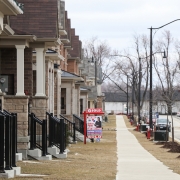Building the right homes to meet the demands of the population is essential to avoid a sizeable deficit in housing supply in the Greater Toronto and Hamilton region. A new report from the Residential and Civil Construction Alliance of Ontario warns that the region is at risk of missing provincial population targets, which could potentially result in 7,200 fewer new homes being built each year until 2041.
The report says that homes to encourage seniors to downsize and to provide the right space for families are essential to avoid skewing the region’s population older with a resulting impact on the economy.
The report – GTHA’s Unbalanced Housing Stock: Benchmarking Ontario’s New LPAT System – says that up to 165,600 homes are at risk of not being built over the next 23 years, equal to an annual loss of $1.95 billion in GDP from residential construction activity if various constraints continue to inhibit the goals set by the provincial growth plan, Places to Grow.
Medium density homes – the so called ‘missing middle’ are key to addressing this issue says Paul Smetanin – president of socio-economic research and data firm the Canadian Centre for Economic Analysis (CANCEA)who conducted the research.
“Hamilton has made the most progress on the ‘Missing Middle,'” Smetanin says. “Toronto, Mississauga, Markham, Newmarket less so, while Brampton is biased towards lower density starts.”
The big issues
The report highlights the key issues for the region’s most populous municipalities including:
- Only 15% of GTHA households live in medium-density housing, which leads to an inadequate supply of appropriate housing types for a range of household sizes and budgets.
- Toronto’s number of annual starts is 5-15% higher than required to hit P2G targets. However, the mix of housing is constrained by land, meaning the city’s supply will be highly skewed towards taller towers.
- York Region is the only one in the GTHA with current annual starts on pace to meet its future target population.
- Among municipalities with populations over 80,000 people, Oshawa, Brampton and Newmarket have the lowest share of higher-density starts.
- Municipalities can better optimize infrastructure investments by ensuring that community growth planning is based on a long-term and strategic analysis of our future housing requirements.










 Maziar Moini, Broker of Record - Home Leader Realty Inc.
300 Richmond St. W., #300, Toronto, ON M5V-1X2
Maziar Moini, Broker of Record - Home Leader Realty Inc.
300 Richmond St. W., #300, Toronto, ON M5V-1X2



